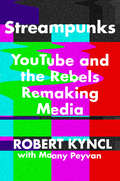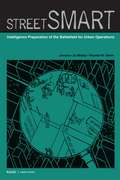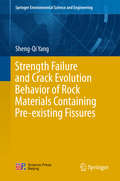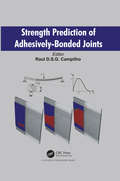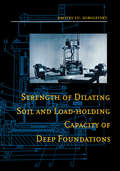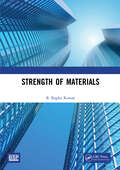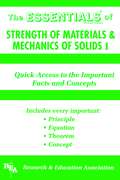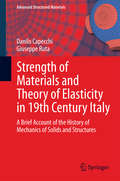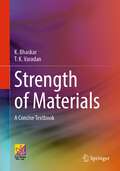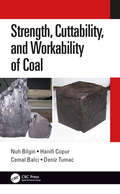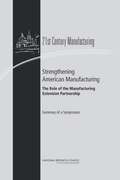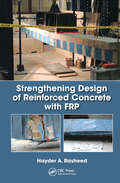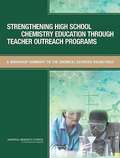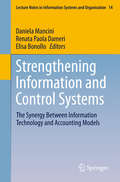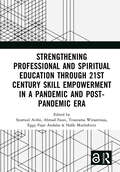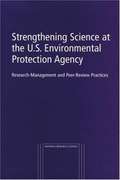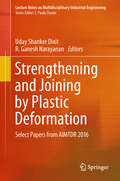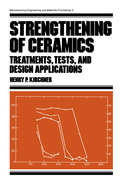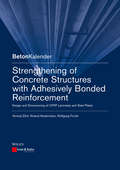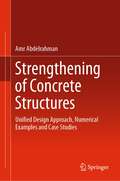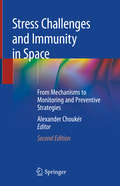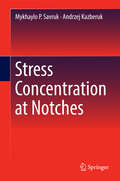- Table View
- List View
Streampunks: YouTube and the Rebels Remaking Media
by Robert Kyncl Maany PeyvanAn entertainment and tech insider—YouTube’s chief business officer—delivers the first detailed account of the rise of YouTube, the creative minds who have capitalized on it to become pop culture stars, and how streaming video is revolutionizing the media world.In the past ten years, the internet video platform YouTube has changed media and entertainment as profoundly as the invention of film, radio, and television did, more than six decades earlier. Streampunks is a firsthand account of this upstart company, examining how it evolved and where it will take us next.Sharing behind-the-scenes stories of YouTube’s most influential stars—Streampunks like Tyler Oakley, Lilly Singh, and Casey Neistat—and the dealmakers brokering the future of entertainment like Scooter Braun and Shane Smith, Robert Kyncl uses his experiences at three of the most innovative media companies, HBO, Netflix, and YouTube, to tell the story of streaming video and this modern pop culture juggernaut. Collaborating with Google speechwriter Maany Peyvan, Kyncl explains how the new rules of entertainment are being written and how and why the media landscape is radically changing, while giving aspiring Streampunks some necessary advice to launch their own new media careers.Kyncl persuasively argues that, despite concerns about technology impoverishing artists or undermining artistic quality, the new media revolution is actually fueling a creative boom and leading to more compelling, diverse, and immersive content. Enlightening, surprising, and thoroughly entertaining, Streampunks is a revelatory ride through the new media rebellion that is reshaping our world.
Street Smart: Intelligence Preparation of the Battlefield for Urban Operations
by Russell W. Glenn Jamison Jo MedbyIntelligence preparation of the battlefield (IPB), the Army's traditional methodology for finding and analyzing relevant information for its operations, is not effective for tackling the operational and intelligence challenges of urban operations. The authors suggest new ways to categorize the complex terrain, infrastructure, and populations of urban environments and incorporate this information into Army planning and decisionmaking processes.
Streitbeilegung in Bauvorhaben: Ansatz, Ablauf, Lösungen (essentials)
by Mario H. KrausBauvorhaben führen nicht selten zu Streitigkeiten zwischen Bauherren, Bauträgern, Behörden oder der Nachbarschaft. Dieser Leitfaden verhilft zu einem Überblick über Möglichkeiten der außer- und vorgerichtlichen Streitbeilegung - mit Checklisten, Adressen, Arbeitsansätzen und Verweisen auf die Rechtsgrundlagen.
Strength Failure and Crack Evolution Behavior of Rock Materials Containing Pre-existing Fissures
by Sheng-Qi YangThis book has following unique features that distinguish it from other works from the same area: 1) Investigates the influence of fissure geometry on strength failure and crack evolution behaviour of real rock material; 2) Analyzes the effect of pre-experiment high-temperature treatment on fracture mechanical behaviour of rock material with a single fissure or two parallel fissures; 3) Compares quantitatively simulated results using discrete element modelling and experimental results of fracture mechanical behaviour of rock material with two fissures; 4) Constructs the relationship between crack evolution processes and acoustic emission distribution of pre-fissured rock material under entire deformation; and 5) Discusses the crack evolution mechanism of pre-fissured rock material with respect to different confining pressures. This book can become the reference for technicians in the field of geotechnical engineering, mining engineering and geology engineering. At the same time, this book can be regarded as a good reference for scientific researchers carrying out fissured rock mechanics and correlated specialties.
Strength Prediction of Adhesively-Bonded Joints
by Raul D.S.G. CampilhoAdhesively-bonded joints provide many advantages over conventional mechanical fasteners and are increasingly receiving attention as an alternative to mechanical joints in engineering applications. The traditional fasteners usually result in the cutting of fibers and hence the introduction of stress concentrations, both of which reduce structural integrity. By contrast, bonded joints are more continuous and have potential advantages of strength-to-weight ratio, design flexibility, and ease of fabrication. This book provides an overview of available analytical methods as well as numerical methods.
Strength and Conditioning for the Human Weapon System
by Christopher Myers Cj FrenchA central focus of the US Military is the Human Weapon System (HWS) and the optimization of this weapon system. Over the past decade, the Department of Defence has invested in programs termed Human Performance Optimization (HPO) programs. Human performance for the human weapon system is much different than the civilian athlete. Therefore, the human weapon system's rehabilitation and performance training requirements are different and must be considered. This book demonstrates the following to strength coaches and practitioners: Why to view the HWS as a multi-faceted system that requires a more inclusive program than needed by athletes. Provide updated methodology to create a strength and conditioning program specifically for the HWS populations. Introduce and define advanced strength and conditioning methodologies SC professionals use within the US Military and law enforcement performance programs.
Strength of Dilating Soil and Load-holding Capacity of Deep Foundations: Introduction to theory and practical applications
by D. Yu SobolevskyIntroduces the theory and practical application of dilating soil and the load-holding capacity of deep foundations. Topics covered include dilatancy as a fundamental property of granular media, direct shear in conditions of constrained dilatancy, and load-holding capacity of a single pile.
Strength of Materials
by B. Raghu KumarThis book follows a simple approach, and introduces analytical procedures to analyze various structural members subjected to different types of loading with step-by-step problem-solving procedure is discussed.The book covers some advanced topics like curved beams, shear center, unit load method. Aa exclusive chapter on "Solving through ANSYS" covers the approach and usage of ANSYS software. Note: T& F does not sell or distribute the Hardback in India, Pakistan, Nepal, Bhutan, Bangladesh and Sri Lanka.
Strength of Materials & Mechanics of Solids I Essentials
by The Editors of REAREA's Essentials provide quick and easy access to critical information in a variety of different fields, ranging from the most basic to the most advanced. As its name implies, these concise, comprehensive study guides summarize the essentials of the field covered. Essentials are helpful when preparing for exams, doing homework and will remain a lasting reference source for students, teachers, and professionals. Strength of Materials & Mechanics of Solids I includes axial force, shear force, bending moment, stress, strain, stress-strain relations, center of gravity, centroids, moment of inertia, and design and deflection of beams.
Strength of Materials and Theory of Elasticity in 19th Century Italy
by Danilo Capecchi Giuseppe RutaThis book examines the theoretical foundations underpinning the field of strength of materials/theory of elasticity, beginning from the origins of the modern theory of elasticity. While the focus is on the advances made within Italy during the nineteenth century, these achievements are framed within the overall European context. The vital contributions of Italian mathematicians, mathematical physicists and engineers in respect of the theory of elasticity, continuum mechanics, structural mechanics, the principle of least work and graphical methods in engineering are carefully explained and discussed. The book represents a work of historical research that primarily comprises original contributions and summaries of work published in journals. It is directed at those graduates in engineering, but also in architecture, who wish to achieve a more global and critical view of the discipline and will also be invaluable for all scholars of the history of mechanics.
Strength of Materials: A Concise Textbook
by K. Bhaskar T. K. VaradanThis textbook has been written for the engineering students. This textbook covers the essentials of solid mechanics with reference to basic load-bearing members—straight bars, thin-walled cylindrical and spherical pressure vessels, circular shafts, beams undergoing simple bending, and columns. It concisely elucidates the corresponding fundamental assumptions, important equations, and their range of validity without formal derivations. Subsequently, this textbook contains several carefully selected examples to illustrate sequence of steps in the analysis of forces, stresses and displacements, or stability. It further deals with combined loading, stress and strain transformations, energy methods, and failure analysis using commonly employed criteria. This textbook is a handy, yet complete, resource for graduate and postgraduate engineering students. It will also be a ready reference for a practicing engineers or graduate students preparing for an interview or a competitive examination.
Strength, Cuttability, and Workability of Coal
by Nuh Bilgin Hanifi Copur Cemal Balci Deniz TumacWorld coal production will increase up to 2040 and world energy consumption will be very much dependent on coal. For a better planning of coal mining operations, it is essential to know the strength, cuttability and workability of coal, which are interrelated. The main objective of the book is to combine the research studies and compile the book oriented to the coal industry, research students, practicing engineers, and coal mine panning teams. Key Features Covers all the subjects related to coal properties, mining and excavation in one book Presents a summary of physical and mechanical properties of coal belonging to a wide range of countries Includes typical examples of using physical and mechanical of coal in mine planning and in its industrial applications Explains use of cuttability characteristics of coal Describes planning of coal production using ploughs, shearers and surface miners
Strengthening American Manufacturing
by National Research Council Charles W. Wessner Policy and Global Affairs Board on Science, Technology, and Economic Policy Committee on 21st Century Manufacturing: The Role of the Manufacturing Extension Partnership Program of the National Institute of Standards and TechnologyThe Manufacturing Extension Partnership (MEP)-- a program of the U.S. Department of Commerce's National Institute of Standards and Technology (NIST)-- has sought for more than two decades to strengthen American manufacturing. It is a national network of affiliated manufacturing extension centers and field offices located throughout all fifty states and Puerto Rico. Qualified MEP Centers work directly with small and medium manufacturing firms in their state or sub-state region, providing expertise, services and assistance directed to foster growth, improve supply chain positioning, leverage emerging technologies, upgrade manufacturing processes, develop work force training, and apply and implement new information. Strengthening American Manufacturing: The Role of the Manufacturing Extension Partnership is the summary of a symposium convened to review current operations and some of the recent MEP initiatives in the broader context of global manufacturing trends and the opportunities for high-value manufacturing companies. Business leaders, academic experts, and state and federal officials addressed the metrics and impacts of MEP and identified potential areas of improvement. The meeting drew attention to the scale and focuses of MEP, and highlighted the role it plays in supporting and enabling U.S. manufacturers to compete more effectively in the global marketplace. This report includes an overview of key issues raised at this workshop and a detailed summary of the conference presentations.
Strengthening Design of Reinforced Concrete with FRP (Composite Materials)
by Hayder A. RasheedThis textbook establishes the art and science of strengthening design of reinforced concrete with FRP beyond the abstract nature of the design guidelines. It addresses material characterization, flexural strengthening of beams and slabs, shear strengthening of beams, and confinement strengthening of columns. It discusses the installation and inspection of FRP as externally bonded or near-surface-mounted composite systems for concrete members. It provides innovative design aids based on ACI 440 code provisions, end-of-chapter questions, references for further study, and a solutions manual with qualifying course adoption.
Strengthening High School Chemistry Education Through Teacher Outreach Programs: A Workshop Summary To The Chemical Sciences Roundtable
by National Research Council of the National AcademiesA strong chemical workforce in the United States will be essential to the ability to address many issues of societal concern in the future, including demand for renewable energy, more advanced materials, and more sophisticated pharmaceuticals. High school chemistry teachers have a critical role to play in engaging and supporting the chemical workforce of the future, but they must be sufficiently knowledgeable and skilled to produce the levels of scientific literacy that students need to succeed. To identify key leverage points for improving high school chemistry education, the National Academies' Chemical Sciences Roundtable held a public workshop, summarized in this volume, that brought together representatives from government, industry, academia, scientific societies, and foundations involved in outreach programs for high school chemistry teachers. Presentations at the workshop, which was held in August 2008, addressed the current status of high school chemistry education; provided examples of public and private outreach programs for high school chemistry teachers; and explored ways to evaluate the success of these outreach programs.
Strengthening Information and Control Systems
by Daniela Mancini Renata Paola Dameri Elisa BonolloThis book presents a collection of original research papers focused on the relationship between information technology and accounting and control models. The book discusses the importance of establishing a synergetic relationship between new information technologies (ERP, BI, web-based technology, data mining, XBRL, etc. ) and new or renewed accounting models and tools (performance indicators, prevision and simulation models, accounting models for public administration, etc. ) in order to enhance an organization's capability to manage information and make valuable decisions. The search for these synergies takes place at all organizational levels: at a strategic level, in order to simulate and forecast behaviors and financial results at a management level, in order to innovate performance measurement and improve value creation at the operational level, in order to improve information quality and the efficiency of the information process. This book is particularly useful for IS and CFO managers and scholars, as it is based on a selection of the best papers - original, double blind reviewed contributions - presented to the Annual Conference of the Italian Chapter of AIS under the category "Accounting Information Systems".
Strengthening Professional and Spiritual Education through 21st Century Skill Empowerment in a Pandemic and Post-Pandemic Era: Proceedings of the 1st International Conference on Education (ICEdu 2022), September 28, 2022, Malang, Indonesia
by Syamsul Arifin Ahmad Fauzi Triastama Wiraatmaja Eggy Fajar Andalas Nafik MuthohirinDiscover a treasure trove of knowledge in the proceedings of the First International Confer-ence on Education (ICEdu). This meticulously curated collection of research papers delves into the transformative landscape of education in the 21st century, offering insights, solutions, and inspiration for educators, researchers, and policymakers alike.Explore a diverse range of subject areas, from pedagogical innovations to the challenges of digital learning and the impact of the COVID-19 pandemic on education. With 28 scholarly papers contributed by experts from around the world, this volume offers a comprehensive un-derstanding of the multifaceted issues in contemporary education.Whether you're an academic seeking fresh perspectives or an educator navigating the com-plexities of modern pedagogy, these proceedings provide invaluable guidance. Join us in shap-ing the future of education by harnessing the power of 21st-century skills, professional devel-opment, and spiritual growth.This book is an essential resource for anyone passionate about the advancement of education in the pandemic and post-pandemic era.The Open Access version of this book, available at http://www.taylorfrancis.com, has been made available under a Creative Commons Attribution-Non Commercial-No Derivatives (CC-BY-NC-ND) 4.0 license. Funded by Universitas Muhammadiyah Malang, Indonesia.
Strengthening Science at the U.S. Environmental Protection Agency: Research-Management and Peer-Review Practices
by Committee on Research Peer Review in EPAInformation on Strengthening Science at the U.S. Environmental Protection Agency
Strengthening and Joining by Plastic Deformation: Select Papers from AIMTDR 2016 (Lecture Notes on Multidisciplinary Industrial Engineering)
by Uday Shanker Dixit R. Ganesh NarayananThis book focuses on strengthening and joining materials by means of plastic deformation, gathering extended research papers presented at the AIMTDR 2016 conference. Plastic deformation is used in materials processing to improve the strength of the material. For example, the rod/screw used to connect the cooker handle to the main body has to be strong and sustainable; such rods can be strengthened by plastic deformation (using multi-stage forming operations etc.). Similarly, joining by means of plastic deformation is highly valuable since it avoids the material and environmental degradation often caused by fusion welding processes. The book discusses various processing techniques in which plastic deformation is used to strengthen materials – e.g. in equal channel angular extrusion, autofrettage etc., or to join materials without melting them – e.g. in friction stir processing, riveting etc. Offering an extensive guide, the book includes chapters on roll bonding, equal channel angular pressing, autofrettage, friction stir processing/welding, magnetic pulse welding, and riveting – processes used to strengthen and join a variety of materials for lightweight applications and sustainable manufacturing. The contents of this book will be useful to researchers and practitioners alike.
Strengthening of Ceramics: Treatments: Tests, and Design Applications (Manufacturing Engineering and Materials Processing)
by Henry Paul KirchnerThis book presents the descriptions of individual treatments and resulting improvements in the strength of polycrystalline ceramics and oxide single crystals. It provides information on potential applications, limitations of the treatments, design considerations, and costs.
Strengthening of Concrete Structures with Adhesively Bonded Reinforcement: Design and Dimensioning of CFRP Laminates and Steel Plates
by Roland Niedermeier Wolfgang Finckh Konrad ZilchDesign and construction in existing contexts is becoming increasingly important, and often the structures - sometimes of historical interest - can be preserved easily and at minimum cost by employing strengthening measures. Existing concrete members can be strengthened by using adhesives to bond additional reinforcing elements onto or into those members. This book explains the design rules, together with their background, and uses examples to illustrate their use, specifically for slabs, beams and columns. Concrete member strengthening measures can take the form of, for example, flexural strengthening with externally bonded (surface-mounted) CFRP strips, CF sheets and steel plates, flexural strengthening with CFRP strips bonded in slits (near-surface-mounted reinforcement), shear strengthening with externally bonded CF sheets and steel plates, and column strengthening with CF sheets as confining reinforcement. The explanations and background information provided are mainly based on the new German guideline "Strengthening of Concrete Members with Adhesively Bonded Reinforcement" by the German Committee for Structural Concrete (DAfStb). This is the first European guideline to regulate this topic in the form of a supplement to the Eurocode. As it is planned to produce a document in a future Eurocode 2, the DAfStb guideline serves as a starting point. The authors are extensively involved in the planning, design, operation and inspection of buildings for preservation and reconstruction, and in the updating of European Technical Approval Guidelines (ETAGs) and design rules. Selected chapters from the German concrete yearbook are now being published in the new English "Beton-Kalender Series" for the benefit of an international audience. Since it was founded in 1906, the Ernst & Sohn "Beton-Kalender" has been supporting developments in reinforced and prestressed concrete. The aim was to publish a yearbook to reflect progress in "ferro-concrete" structures until - as the book's first editor, Fritz von Emperger (1862-1942), expressed it - the "tempestuous development" in this form of construction came to an end. However, the "Beton-Kalender" quickly became the chosen work of reference for civil and structural engineers, and apart from the years 1945-1950 has been published annually ever since.
Strengthening of Concrete Structures: Unified Design Approach, Numerical Examples and Case Studies
by Amr AbdelrahmanThis book presents unified design approach for strengthening concrete members with different techniques such as concrete, steel, and FRP jacketing. Preference between the various techniques is explained in light of strengthening limits, procedures, and application for each case. Examples for evaluation of existing structures and design equations for strengthening concrete elements are presented based on the ACI design codes and standards. Numerical examples are also given for different strengthening techniques with illustrations for the construction methodology and detailing for each case.Several case studies are explained starting from problem diagnosis, structure analysis, proposal for different strengthening methodologies, and implementation procedure for the selected scheme. The case studies include structures subjected to gravity loads, lateral loads, elevated temperature, and differential settlement of the foundations. It addresses design and construction errors, environmental impact, and soil movement. The case studies include conventional reinforced concrete, post-tensioned, and precast concrete members.
Strengthening the Human Right to Sanitation as an Instrument for Inclusive Development (IHE Delft PhD Thesis Series)
by Pedi Chiemena ObaniOver a third of the current 7.3 billion people worldwide are burdened with poor sanitation services. The resulting social, relational and ecological exclusion make the realisation of the human right to sanitation (HRS) a critical concern development concern. However, the literature has evolved in a largely compartmentalised manner, focusing on the formal recognition of the HRS in domestic legal systems, without sufficiently addressing the drivers of poor sanitation services. This research expounds on the impact of the HRS on human wellbeing and the environment within the context of a developing country like Nigeria as a case study. The findings show that contrary to the focus in the literature, the drivers of poor sanitation services are not confined to legal factors, such as the formal recognition of the HRS within domestic legal systems. Rather, the drivers include social, economic and environmental limitations to improved sanitation services. Based on the findings, the book argues that the focus in the literature on the formal recognition of the HRS in national legal systems is insufficient for tackling the main drivers of poor sanitation services. It is therefore necessary to reformulate the HRS discourse using complementary governance instruments that advance social, relational and ecological inclusion.
Stress Challenges and Immunity in Space: From Mechanisms to Monitoring and Preventive Strategies
by Alexander ChoukérThis book explains how stress – either psychological or physical – can activate and/or paralyse human innate or adaptive immunity. Adequate immunity is crucial for maintaining health, both on Earth and in space. During space flight, human physiology is specifically challenged by complex environmental stressors, which are most pronounced during lunar or interplanetary missions. Adopting an interdisciplinary approach, the book identifies the impact of these stressors – the space exposome – on immunity as a result of (dys-)functions of specific cells, organs and organ networks. These conditions (e.g. gravitation changes, radiation, isolation/confinement) affect immunity, but at the same time provide insights that may help to prevent, diagnose and address immune-related health alterations. Written by experts from academia, space agencies and industry, the book is a valuable resource for professionals, researchers and students in the field of medicine, biology and technology.The chapters “The Impact of Everyday Stressors on the Immune System and Health”, “Stress and Radiation Responsiveness” and “Assessment of Radiosensitivity and Biomonitoring of Exposure to Space adiation” are available open access under a Creative Commons Attribution 4.0 International License via link.springer.com.
Stress Concentration at Notches
by Mykhaylo P. Savruk Andrzej KazberukThis book compiles solutions of linear theory of elasticity problems for isotropic and anisotropic bodies with sharp and rounded notches. It contains an overview of established and recent achievements, and presents the authors' original solutions in the field considered with extensive discussion. The volume demonstrates through numerous, useful examples the effectiveness of singular integral equations for obtaining exact solutions of boundary problems of the theory of elasticity for bodies with cracks and notches. Incorporating analytical and numerical solutions of the problems of stress concentrations in solid bodies with crack-like defects, this volume is ideal for scientists and PhD students dealing with the problems of theory of elasticity and fracture mechanics.
